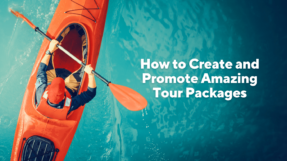Whether it brings you joy or you consider it to be the bane of your existence, writing is a practice that is often unavoidable. This holds true for any business in the tourism and travel industry. How well you write can be the difference between a new customer booking or a lost opportunity. Fortunately, copywriting is an art form with very specific techniques that you can start using right away to enhance your own content.
While the purpose of conversion copywriting is not always necessarily to make a sale, the goal of your tour description ultimately is to get your customers to book your tour. The good news is that we’re here to help by sharing some online copywriting and marketing tips for more persuasive writing in your tour descriptions.
Know Your Audience

The first step to crafting an amazing tour description happens even before you begin to write, and that is understanding your target audience. Even the best piece of written content can fall flat if you don’t know whom you’re speaking to or writing for.
Knowing your audience goes beyond just their demographic (age, ethnicity, gender, marital status, income, etc.). By conducting surveys with your customer base, creating audience personas, and doing some good old-fashioned research, you can begin to understand the deeper motivations and values your customers have.
Once you determine who your audience is and what their wants, needs, and pain points are, you can start to tailor your message to them in order to create an even bigger impact. You’ll soon discover how big a difference this makes to your bottom line.
Unique Selling Points and Catchy Headlines
Discover what makes you unique and emphasize it to set yourself apart. If your customer hasn’t sought out your business specifically, chances are that they’re browsing a handful of other companies that provide an experience similar to your own. Say you run a tour company that guides travellers on a gorgeous hike through the forest. What factors differentiate you from the other hikes in your area, or even from any other hike in the world for that matter? It’s important to remember that your unique selling points (USP) should not only be what makes you different, but what makes you better than your competition.
Different studies have shown varying results, but the general consensus is that the attention span of the average reader online has decreased over the years to about 8 seconds. This makes it increasingly important to create a powerful first impression. The first thing that potential customers read when landing on your tour description is your title, so you should focus your efforts on crafting a catchy headline that will grab their attention by highlighting your USP.
Storytelling Techniques

Explore the ‘Why’ to Evoke Reader Emotions
One of the keys to writing the best tour description is to learn the art of storytelling. The best stories are the ones that evoke emotions in readers and make them feel. Earlier, we discussed the importance of knowing your audience. Understanding your customers’ motivations and values can help uncover why they’re seeking out your tour, which is more valuable than what they’re seeking.
Your customers may be looking for a cliffside trek in the mountains, but the bigger question is why? Is it for the thrill and the adventure? Is it for the challenge? Is it a spiritual journey? Are they looking for a way to reconnect with nature? Figuring this out allows you to craft a tour description that addresses their deeper desires. Focus on how your tour provides them with a solution to fulfilling their needs and you’ll quickly create a strong emotional connection with your audience.
Use Vivid Descriptions That Appeal To The Senses
Avoid using this space to explain all of the features your tour has to offer. Instead, weave a tale that brings your audience along for the journey by showing them what’s in store for them. The important word here being ‘show’ and not ‘tell’. Vivid descriptions that appeal to the senses will help your audience visualize the scene that you’ve created as if they are living in it. By the end of your tour description, your potential customer should know without a shadow of a doubt that your tour is something they need to experience firsthand. All that’s left for them to do is to book.
Speak Directly To Your Audience
To really help your audience imagine themselves enjoying your tour, write as if you are speaking directly to them. Writing in the first or second person point-of-view is a great way to ensure that your tour descriptions are as engaging as possible. This means using words like ‘you’ and ‘your’ when referring to your potential customer or reader. Also, opt to use the active voice instead of the passive voice to help keep your tour descriptions exciting. For example, you can say “You’ll explore a beautiful mountain range” rather than “You will be guided through a beautiful mountain range.”
Need help understanding the active voice and reducing the use of the passive voice in your writing? Check out this passive voice detector to identify opportunities where you can strengthen your message by restructuring your sentence.
Be Clear and Concise
Tell your story so that it moves your audience, but try to keep your tour descriptions clear and concise. Most readers prefer things that are easy to read both in content and in the way it is laid out on the page. Structure your tour description so that it is visually inviting by using bullets and headlines, and avoiding huge chunks of text.
Incorporate Tour Features and Highlights

We mentioned earlier to avoid bogging down the storytelling aspect of your tour description with features, but that doesn’t mean you should leave them out entirely. The best way to incorporate a list of features is in bullet point form after the main description. This is also a great section to highlight key points about your tour and communicate important information like how to prepare for the experience, what’s included with the tour, and what isn’t. Using a list makes the information easily digestible and quicker to locate when needed.
Try to anticipate the questions your audience will have and the type of information they’ll be looking for. Proactively providing the answers to these will help your customers feel more confident about booking your tour.
Enhance Your Tour Description with Visual Media
Including visual media like beautiful photos or stunning videos can enhance your tour description in a way that words can’t. If the goal of your writing is to help your audience picture what it’s like to be on your tour, what better way to accomplish that than to show them? Give your audience a glimpse of what they can expect with shots of fantastic landscapes and happy customers. Just make sure that you’re using high-quality photos and videos so that they represent your tour in the best way possible. The last thing you want is for a poor photo to detract from a wonderfully-written tour description and drive away potential customers.
If you’re ready to snap some amazing shots for your tour description, check out these great photography tips for tour operators.
Use SEO Best Practices

Search engine optimization (SEO) is the process of improving the word choices in your written content to increase your visibility online. This applies to your tour descriptions just as it would any other website content. Use specific keywords in your tour description to ensure your website gets in front of the eyes of the right people online.
If you need some help with improving the SEO of your tour descriptions or your tour business in general, check out these 9 free SEO tools for tour operators.
Honesty and the Power of Testimonials
Be honest and transparent about what your tour offers and what it doesn’t. Be passionate and enthusiastic, but don’t forget to be genuine. You want to excite and inspire your potential customers without exaggerating the truth. Making misleading claims never ends well and you risk disappointing your customers and damaging your tour business’ reputation if you do.
Last, but not least, positive testimonials and reviews are an excellent addition to your tour description if you have them. When potential customers read happy reviews from their fellow travellers, it can help to build their own confidence and trust in your company.
Remember, understanding your audience, discovering what makes your tour unique, and focusing on storytelling are key to writing tour descriptions that sell by converting your visits into bookings. There’s a lot to consider when writing descriptions for your tour and travel company, but we have complete confidence that if you follow these steps you’ll be well on your way to writing some of the most impactful tour descriptions around.





